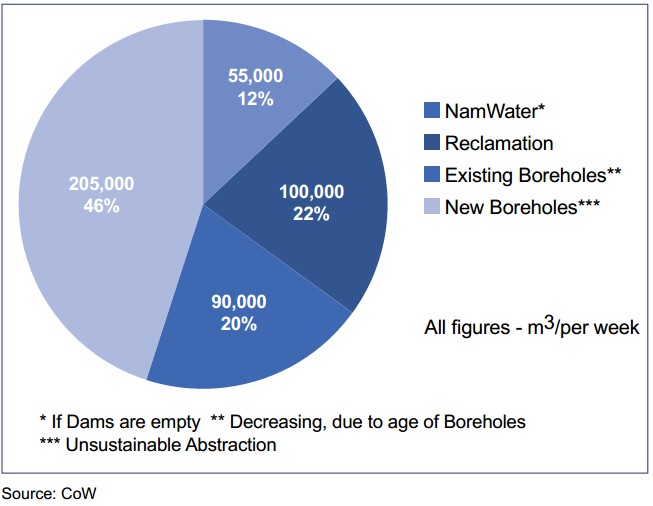As part of the City of Windhoek’s response to the water crisis from 2015-16, the authorities drew up an ‘Emergency Water Use Scenario’. The scenario seeks to capture from which source and how much volume should be provided to meet the city’s water demand over the period of one week. Of note and as can be seen on the graph is the extremely low volume of water that NamWater would be able to supply in a drought situation with the dams being empty. Just 12 percent of the total emergency water supply would come from Namibia’s only bulk-water supplier. Contrast this with the high volume of water drawn under this scenario from Windhoek’s natural aquifer. The new boreholes, constructed only very recently are expected to supply nearly half of the required water.

Yet it is estimated that the sustainable yield of the aquifer is only around 1.7 million cubic meters per year – a volume that would be exceeded in less than nine weeks under this scenario. Public concerns, especially regarding the possible negative environmental impact of pumping large volumes of groundwater rapidly from the aquifer, are justified. However, the scenario already limits total water use by the city to 450,000 cubic meters per week – yet on average Windhoek already uses around 590,000 cubic meters per week. Hence even the targeted reduced water use under the emergency scenario is considerable. Overall it can be stated that the city’s water demand is unsustainable. It also should be kept in mind that targets for water savings, on which the scenario is based, have seldom been meet during the course of the crisis. Being an emergency measure the scenario is only intended for short-term guidance. Nevertheless, looking closely at the figures it indicates how precarious Windhoek’s water situation really is. As citizens we need to urgently re-consider and discuss the envisioned long-term future of Windhoek in being the economic hub of Namibia.
This post is based on our recent publication on Windhoek’s water crisis. You can access the full report here.

